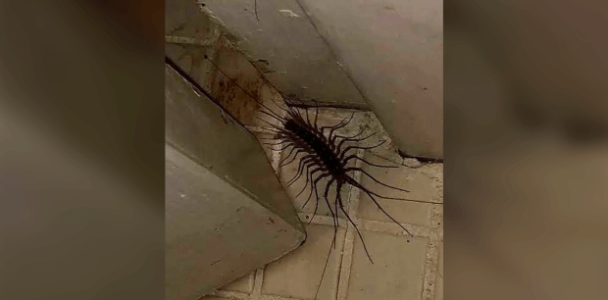Aussie terrified by 'nightmare' critter at home—is it dangerous?
- Replies 16
Ah, Australia—the land of golden beaches, barbies, and seemingly endless brushes with insects and wildlife, both tame and wild.
More often than not, these run-ins can be quite amusing, and if you're familiar with the type of critter you're dealing with, they might even be quite cute!
But while it might sound like all those wild encounters put Aussies in an enviable position, it's the opposite; each one can present its own set of risks and dangers and is sometimes a sight that requires a double take.
That was the case for an Australian who encountered an extremely peculiar creature in their home and couldn't believe their eyes.

That is why they took to social media to share a photo of the strange critter. Unsurprisingly, it instantly caught the attention of many other Australians, who were just as baffled and shocked as the homeowner.
The photo shows a large, creepy-looking black bug with dozens of extremely long legs; some have described it as 'nightmare material'.
One user wrote, 'What is that?', while countless others picked up on the fact that house centipedes are indeed a speedy little critter, with one user warning, 'Those little fellas are fast. And I mean real fast.'
However, there was no cause for alarm, as the insect in question is a non-threatening native species known as the house centipede, which can have up to 191 legs.
Ciaran Mathewson, an expert from the Australian Museum, explained that the bug's body is divided into many tiny segments, each of which has one pair of legs.
As the name suggests, house centipedes are typically found in homes and across urban areas and forests. They can usually be seen scurrying around with only their fast legs visible.
'They have modified their front legs into venom-filled appendages called forcipules. However, it is not common at all to be stung,' Mr Mathewson added, explaining that the forcipules are 'not very strong', making it hard for them to pierce human skin.
But if one does happen to successfully pierce your skin, the symptoms will likely consist of a sensation similar to that of a bee sting—redness, pain, and a general feeling of discomfort.
So, while we don't recommend personally handling them or attempting to remove them with a pair of tweezers, we also want to point out that having a house centipede around isn’t as terrifying as it seems.
That's because they're actually incredibly beneficial to humans. These native creatures feed on insects like silverfish, bed bugs, and cockroaches, which are considered pests in homes.

You read it here, members! These tiny creatures might just be the unsung heroes quietly and sneakily helping you with your pest problem at home. So, if you ever see one peacefully slithering around, don't bother it! You never know; it might be in the middle of a 'job'!
Have you ever encountered one in your home? Did it resemble the photo above? Or perhaps you've come across other critters in your space? Share your stories with us in the comments below!
More often than not, these run-ins can be quite amusing, and if you're familiar with the type of critter you're dealing with, they might even be quite cute!
But while it might sound like all those wild encounters put Aussies in an enviable position, it's the opposite; each one can present its own set of risks and dangers and is sometimes a sight that requires a double take.
That was the case for an Australian who encountered an extremely peculiar creature in their home and couldn't believe their eyes.

People were shocked by the sight of the strange creature, but they're more common than you think. Credit: Reddit.
That is why they took to social media to share a photo of the strange critter. Unsurprisingly, it instantly caught the attention of many other Australians, who were just as baffled and shocked as the homeowner.
The photo shows a large, creepy-looking black bug with dozens of extremely long legs; some have described it as 'nightmare material'.
One user wrote, 'What is that?', while countless others picked up on the fact that house centipedes are indeed a speedy little critter, with one user warning, 'Those little fellas are fast. And I mean real fast.'
However, there was no cause for alarm, as the insect in question is a non-threatening native species known as the house centipede, which can have up to 191 legs.
Ciaran Mathewson, an expert from the Australian Museum, explained that the bug's body is divided into many tiny segments, each of which has one pair of legs.
As the name suggests, house centipedes are typically found in homes and across urban areas and forests. They can usually be seen scurrying around with only their fast legs visible.
'They have modified their front legs into venom-filled appendages called forcipules. However, it is not common at all to be stung,' Mr Mathewson added, explaining that the forcipules are 'not very strong', making it hard for them to pierce human skin.
But if one does happen to successfully pierce your skin, the symptoms will likely consist of a sensation similar to that of a bee sting—redness, pain, and a general feeling of discomfort.
So, while we don't recommend personally handling them or attempting to remove them with a pair of tweezers, we also want to point out that having a house centipede around isn’t as terrifying as it seems.
That's because they're actually incredibly beneficial to humans. These native creatures feed on insects like silverfish, bed bugs, and cockroaches, which are considered pests in homes.
Key Takeaways
- A photo of a large, intimidating insect found in an Australian home was posted on social media, shocking and scaring followers.
- Despite its terrifying look, the Australian Museum confirmed it's a harmless house centipede, found across the country and known for having up to 191 legs.
- Though scary to look at, the centipedes have weak venom-filled appendages, making it hard for them to pierce human skin. If stung, it has been likened to a bee sting.
- Moreover, having them in the home can be beneficial as they feed on insects considered pests, such as silverfish, bed bugs, termites and cockroaches.
You read it here, members! These tiny creatures might just be the unsung heroes quietly and sneakily helping you with your pest problem at home. So, if you ever see one peacefully slithering around, don't bother it! You never know; it might be in the middle of a 'job'!
Have you ever encountered one in your home? Did it resemble the photo above? Or perhaps you've come across other critters in your space? Share your stories with us in the comments below!
Last edited by a moderator:







